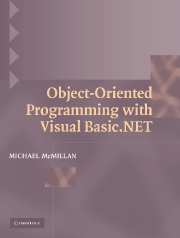Book contents
- Frontmatter
- Contents
- Preface
- Chapter 1 An Overview of the Visual Basic.NET Language
- Chapter 2 An Overview of Object-Oriented Programming
- Chapter 3 Structures
- Chapter 4 Classes
- Chapter 5 Access Modifiers
- Chapter 6 Abstract Classes and Interfaces
- Chapter 7 Implementing the IEnumerable and IComparable Interfaces
- Chapter 8 Designing and Implementing Exception Classes
- Chapter 9 Design Patterns and Refactoring
- Chapter 10 Object Internals: Reflection and Attributes
- Chapter 11 Object Persistence: Serialization
- Chapter 12 Building a Windows Application
- Chapter 13 Database Programming Using ADO.NET
- References
- Index
Chapter 1 - An Overview of the Visual Basic.NET Language
Published online by Cambridge University Press: 06 July 2010
- Frontmatter
- Contents
- Preface
- Chapter 1 An Overview of the Visual Basic.NET Language
- Chapter 2 An Overview of Object-Oriented Programming
- Chapter 3 Structures
- Chapter 4 Classes
- Chapter 5 Access Modifiers
- Chapter 6 Abstract Classes and Interfaces
- Chapter 7 Implementing the IEnumerable and IComparable Interfaces
- Chapter 8 Designing and Implementing Exception Classes
- Chapter 9 Design Patterns and Refactoring
- Chapter 10 Object Internals: Reflection and Attributes
- Chapter 11 Object Persistence: Serialization
- Chapter 12 Building a Windows Application
- Chapter 13 Database Programming Using ADO.NET
- References
- Index
Summary
This chapter presents an overview of the syntax and primary constructs of the Visual Basic.NET (VB.NET) language for programmers unfamiliar with VB.NET. This is not a tutorial chapter, however, so if you are new to programming you should study another text on VB.NET before continuing with this book. If, though, you are coming to VB.NET from some other language, such as C++ or Java or even Visual Basic 6, you should read through this chapter to familiarize yourself with the language.
NET PROGRAMS
There are two ways to build programs in VB.NET. One is to use the Visual Studio.NET Integrated Development Environment (IDE). The other is to use the command-line compiler packaged as part of the.NET Framework Software Development Kit (SDK). In this section we'll discuss developing programs with the command-line compiler, since this software is free and can run on any of the modern Windows operating sysems (Windows 98 and beyond).
VB.NET Program Types
With VB.NET, you can write many different kinds of programs. A VB.NET program that makes use of a graphical user interface (GUI) is a Windows application. A VB.NET program that uses the command-prompt console for input and output is called a Console application. You can also write Internet applications, Windows Services applications, and other types of applications.
- Type
- Chapter
- Information
- Object-Oriented Programming with Visual Basic.NET , pp. 1 - 43Publisher: Cambridge University PressPrint publication year: 2004



